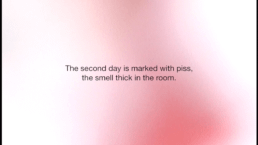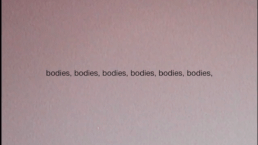The Video Poem: Interventions, Images, and Words on Screen
Julia Madsen
In his touchstone mid-century essay, “The Birth of a New Avant-Garde: La Caméra-Stylo,” Alexandre Astruc develops a theory based on relationships between cinematography and writing, arguing that the filmmaker takes up the caméra-stylo (camera-pen) to write or “author” a film using audiovisual elements. Astruc’s insights, including the idea that the cinema will “become a means of writing just as flexible and subtle as written language,” touch on the meaning of cinematography itself as a kind of “film-writing.” Artists and filmmakers are able to “write” into film through a variety of audiovisual techniques, such as montage and voiceover. In this way, the video poet approaches the blank screen like a blank page, configuring new arrangements between text, image, and sound with an eye and ear for poetics.
Similar to the cinematic essay, the video poem uses the language of cinema and literature to explore the form’s possibilities. Artists like Young-Hae Chang Heavy Industries (YHCHI) merge these respective traditions, creating captivating and innovative work that lends itself to radical critique. Explicitly engaging with social and political discourses, YHCHI’s video work looks closely at relationships between technology and culture in the postmodern moment alongside issues surrounding race, ethnicity, gender, and national identity, among others. For instance, in “Traveling to Utopia: With a Brief History of the Technology,” YHCHI weaves a narrative, or simultaneous narratives at once, which address “how technology serves to produce and reproduce racialized and gendered subject/objects” while also presenting “an ironic commentary on the rhetoric of technological liberation from the constraints of categorical difference” (Warren Liu). While YHCHI primarily uses text on screen in tandem with a soundtrack, other artists rely on varying combinations of sound and image as a means of centralizing the poetic voice. Through its punchy, poetic voiceover coupled with the repeating image of a solider holding an assault rifle, Justin Katko’s “Up Against the Screen Mother Fuckers,” for example, seems to offer an emergent critique of contemporary media saturation and its concomitant sensory assault. Akin to Paul Virilio’s theory put forth in War and Cinema, Katko suggests a particular relationship between war and the cinematic image, implicitly drawing attention to the close ties between the history of war and the history of cinematic technologies.
Inspired by the 1978 dirty protests at the all-women Armagh Prison in Northern Ireland as a response to attacks by prison authorities, Meghan Lamb and Jason Pappariella’s Dirty (Dream Pop Press 2017), brings to life the screen’s “primordial emptiness” (Ágnes Pethő) and fills it with an entire scene depicting a string of days living in a single prison cell during the protests. Text appears and fades against a blank screen, accompanied by deep, penetrating music: “The first day is, as of yet, an unmarked emptiness. / The blue, then gray, then blonde light filters through your cell. / Your cell mate lies and looks up at the ceiling, / sits and looks out at the window, / stands, and picks at paint chips on the wall.” I first watched this video in a small hotel room in the early morning with the blinds closed, and felt as though the room was slowly becoming a cage. Lamb and Pappariella masterfully invoke and build the experience: “The second day is marked with piss, the smell thick in the room. / You breathe it in with every breath, a tinge / of inevitability. / Your first thought, upon waking is: / It’s real. I have done this. / Your second thought, upon waking is: / Fuck.” My favorite moment occurs near the beginning of the video, wherein the viewer encounters the visceral, embodied experience of watching old prison food rot: “You bend above the now / gray hill of food / now rot. / The rot / now fluid filled / now indistinguishable / now / form / now / consumed / . . . / A scoop of white potatoes joins your ever-growing / wet grey pile on the floor. / The new food wakes the maggots. / They come crawling to the surface / like so many sets of small, white fingers / scraping.” This moment captures the abjection and poor sanitary conditions of the dirty protests in living relief, returning history to us in a decaying, decomposing mass of old prison food. The prison cell ultimately becomes a tomb whose walls close in around us, and all that we see is filtered through muted and bloody/abstract visuals.


The power of Dirty resides in its critique with respect to Northern Ireland’s patriarchal prison system, a critique which speaks to ongoing issues surrounding power and oppression. Through its haunting combination of text, sound, and image, this video poem makes for an unforgettable and moving event, documenting an overlooked moment in history through the representation of lived experience.
References:
The idea that the video poet approaches the blank screen like the blank page is inspired by “The Screen is a Blank Page: Jean-Luc Godard’s Word and Image Plays” by Ágnes Pethő in Words and Images on the Screen: Language, Literature and Moving Pictures.
Warren Liu, “Posthuman Difference: Traveling to Utopia with Young-Hae Chang Heavy Industries.”
*
Julia Madsen is a multimedia poet and educator. She received an MFA in Literary Arts from Brown University and is a PhD candidate in English/Creative Writing at the University of Denver. Her first book, The Boneyard, The Birth Manual, A Burial: Investigations into the Heartland (Trembling Pillow Press) was listed on Entropy’s Best Poetry Books of 2018.